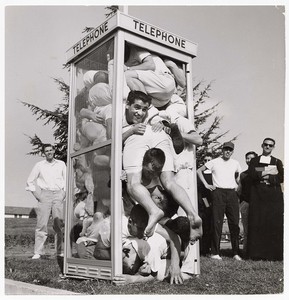Munroe began working as a photographer in 1939 at the Cranbrook Academy of Art in Bloomfield Hills, Michigan, though photography had been a hobby and he had worked as a darkroom technician for several years prior to that. At Cranbrook, in addition to teaching, he served as the staff photographer, creating images of the the faculty, students, and activities of the institution. He left Cranbrook during World War II, to enlist in the United States' Air Force where he worked as a public relations photographer. After his stint in the military, Munroe was employed by Farm Quarterly Magazine, a new publication based in Cincinnati, Ohio, photographing farm and rural life subjects. This was an important time in his career and by the 1950s he had established himself as a premier agricultural photographer. Perhaps because of being raised in the urban environment of Detroit, Joe Munroe was able to bring to his assignments a freshness and uniqueness that came to characterize his work in the future. He says that he enjoyed the challenge of visually interpreting a topic about which he knew very little initially and believes that this way of looking at his subjects remained with him. Munroe also said that the years he spent in Ohio (approximately 1945-1954) were truly the formative years of his career, as it was here that the warmth and directness of his style as an artist developed. One assignment that presented a distinct challenge for Munroe was to photograph "Chris," a steer at The Ohio State University College of Veterinary Medicine. Chris had a fistula (a surgically made hole) in his side so that part of the contents of his first stomach, or rumen, could be removed and analyzed. To accentuate the fistula and supplement the researcher's flashlight, Munroe ran a small, sterilized wire and synchronized flash down into Chris's rumen. Chris was reported to be disconcerted, though unharmed by the procedure. In addition to his well-known rural life and farming images, highlighted in his book, Changing Faces On Our Land, Munroe's archives also includes photographs of politicians, authors, musicians, and other famous people; cities and buildings all over the world; the environment, particularly, though not exclusively, in the midwestern and western United States; and other news and human interest topics. Ultimately working as a freelance photographer, Munroe began expanding his subjects and interests with clients such as Life, National Geographic, Time, Fortune, and Ladies Home Journal. Two of his icon images are the Life picture assignment from 1959 of twenty-one young men stuffed into a phone booth on a California college campus and the 1969 Farm Quarterly cover of the two nuzzling piglets which circulated internationally as a poster. In 1942, while at Cranbrook Academy, he also made his first film: an abstract, black and white film in which lights and shapes move with contemporary jazz music. He resumed film making in the 1960s for corporations such as Pioneer Hybrid International and for public broadcasting. His film career also coincided with his interest in rafting the rivers of the western United States. While making two of his films about the Grand Canyon, Showcase of the Ages and Dare the Wildest River, he led sixteen non-commercial, cooperative rafting trips down the Colorado River. His cinema work, which incorporates the agricultural and environmental themes important to his entire career, has won numerous awards. The Ohio Historical Society



